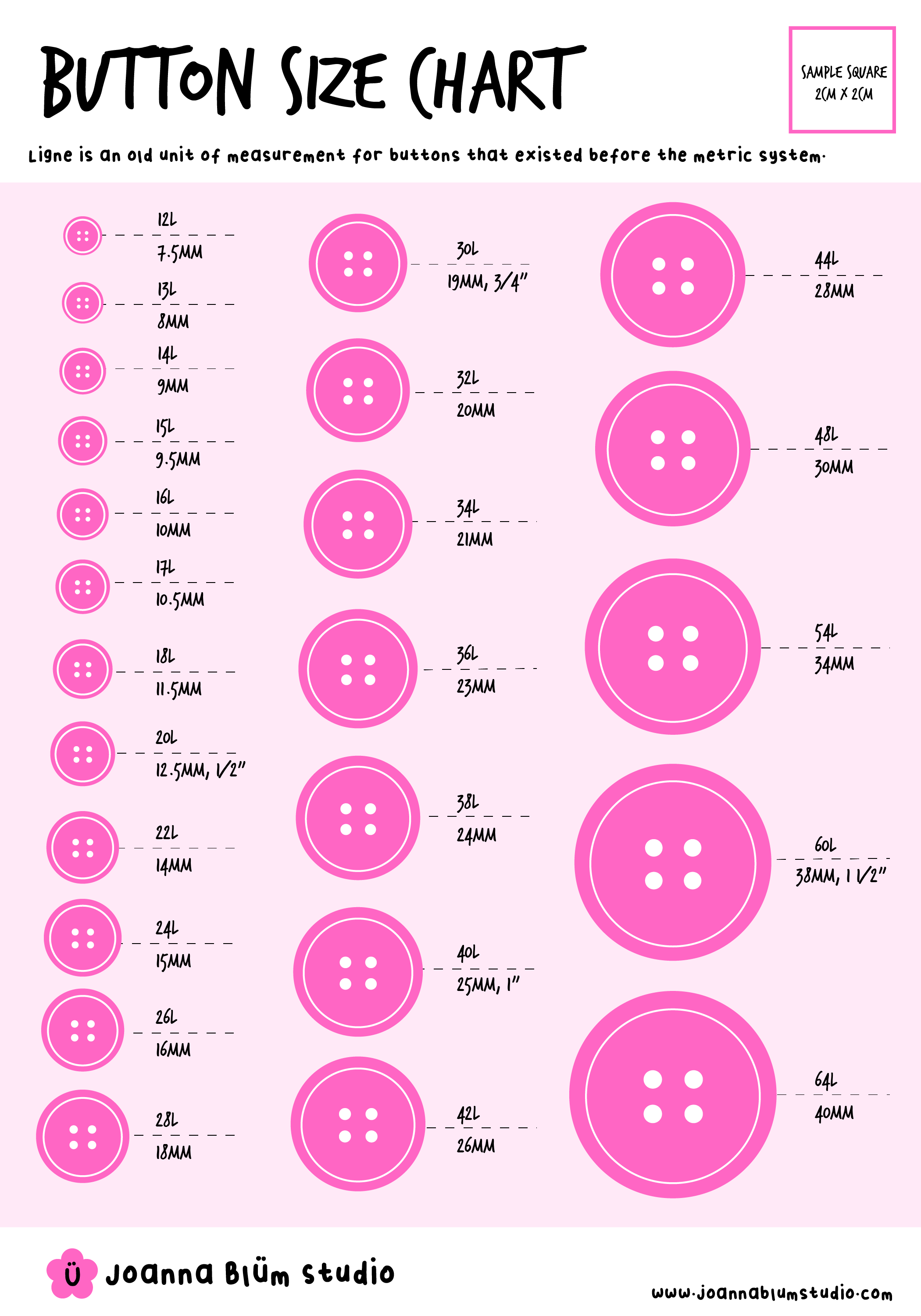Buttons and Buttonholes- Free Button Size Chart

Buttons and buttonholes serve as both functional and ornamental elements, primarily intended to secure two parts of a garment by connecting two garment sides by passing a button through a corresponding opening or loop.

A Brief History:
The exact origins of buttons remain uncertain, as their use dates back to ancient times with no precise historical record. Despite this ambiguity, evidence suggests buttons have been utilized since antiquity, evolving over time into status symbols by the 13th century and intricate adornments resembling jewelry by the 18th century. Influenced by historical events and figures, such as Queen Victoria’s mourning period and Tutankhamen’s discovery, button design has continually evolved. The 20th century saw the advent of new materials like plastic, leading to the diverse range of button options available today, including plastic, metal, and fabric. Source: Western Regional Button Association
Button Sizes & Shapes:

Buttons come in a range of sizes, often denoted by numerical designations such as 14L or 16L. Buttons are sized using the term “ligne”, a French unit of length. The measurement, abbreviated as 1L, starts at 1 and represents the button’s diameter across its widest part.
Download FREE Button Size Chart 💕
Note: Make sure to print it out in actual size; it works perfectly on both letter size and A4 paper!

Alongside these size specifications, buttons also exhibit various geometric shapes, including flat, quarter ball, half ball, and full ball designs. These different sizes and shapes cater to diverse preferences and practical needs in garment fastening and adornment, allowing for both functional and aesthetic versatility.
Basic Types of Buttons:

Sew-Through: These are the most common type of buttons. They have holes through which thread is sewn to attach them to the fabric. They’re generally flat and can have two or four holes. Sew-through buttons are versatile and can be used on a variety of garments, including shirts, jackets, and dresses.
Shank Buttons: These buttons have a loop or “shank” at the back through which the thread is sewn. The shank elevates the button slightly above the fabric, making it easier to button up thicker fabrics or layered clothing. Shank buttons are often used on heavy outerwear, denim, and to secure waistbands.
Types of Buttonholes:

Machine-Stitched: These are the most common type of buttonholes, often used on shirts, blouses, and light jackets. Typically made using a sewing machine, they are reinforced with stitching around the edges. Some machine-stitched buttonholes are designed in a keyhole shape to accommodate larger or decorative buttons.
Bound Buttonholes: Bound buttonholes are often seen on high-quality garments and outerwear. They consist of two small strips of fabric, called “lips,” that are sewn together to create an opening for the button.
Loop Buttonholes: These buttonholes are crafted from narrow strips of fabric, cut on the bias or without any filler or with a thin elastic. They create loops that accommodate a button. They are commonly used for closures on the back of a dress or on delicate, lightweight fabrics.
Useful Tips for Button/Buttonhole:
- Button/Buttonhole Extension:
- Button closures require an overlap extending beyond the center line. The extension should be equal to the diameter of the button.
- The length of a buttonhole is determined by the diameter of a flat button plus an additional 1/8 inch.
- Buttonhole Placement:
- Buttonhole placement generally starts 1/8 inch out from the center front, on the extension.
- Standard button sizes for women’s blouses/shirts, both flat and shank, are typically 16L and 18L. For jackets, it’s usually 32L, based on my decade of experience working as a designer.
- Necklines:
- For a plunging neckline, place buttons and buttonholes closer together to ensure secure closure.
- For a high neckline, spacing can be more generous to allow for ease of fastening.
- Consider Fabric Thickness:
- Adjust buttonhole size and placement based on the thickness of the fabric.
- Thicker fabrics may require larger buttonholes and more space between buttons to accommodate bulk.
- Additional Tips
- Always make a test buttonhole on a scrap piece of fabric to ensure proper fit and functionality before making them on your garment.
- For added durability, consider reinforcing buttonholes with interfacing or a zigzag stitch along the edges.
- Maintain consistency in button and buttonhole placement throughout your garment for a polished look.
- Choose button size proportionate to the garment and its functionality. Larger buttons may require larger buttonholes for ease of use.
- Ensure even spacing between buttons and buttonholes for a balanced appearance and ease of closure.
In Conclusion

While buttons and buttonholes may seem intimidating for beginner sewists and pattern makers, learning more about buttons and how to sew them will greatly enhance your sewing journey, adding depth and versatility to your creations. Don’t let initial challenges deter you – embrace the learning process, and you’ll soon discover the joy and satisfaction of incorporating buttons and buttonholes into your sewing repertoire.
